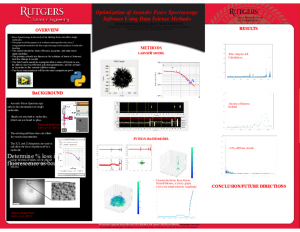Raghuraman, Varun: Optimization of Acoustic Force Spectroscopy Software Using Data Science Methods
Title: Optimization of Acoustic Force Spectroscopy Software Using Data Science Methods
Name: Varun Raghuraman
Major: Computer Engineering
School affiliation: School of Arts and Sciences, School of Engineering
Programs: Aresty Research Fellowship
Other contributors: Markus Hackl
Abstract: Force Spectroscopy is the study of the binding forces that affect single molecules. While it is possible to examine bonding in larger groups through more conventional techniques, there is a greater level of detail that is visible through single molecule methods. The purpose of this project is to evaluate and expand on the use of computational methods with force spectroscopy in the analysis of molecular bonding. The current approach calls for an experimenter to manually review positional data before performing force calibration experiments. By cleaning and preprocessing data from such experiments, it is hoped that analysis of single molecule bonding within the laboratory will be more efficient, accurate, and easy to repeat under varying conditions. Using MATLAB, LabVIEW, and a Jupyter Notebook interface, the data will be cleaned. The sections of interest will be isolated, and used to perform force analysis and anchor point calculations. Most importantly, these calculations will be compared to the manual analysis of the data points under different tolerances and selection criterion. It is believed that an automated approach with greater tolerances (during the isolation stage for the data set) will produce more accurate, useable results than those with a stricter selection. The isolation of areas of interest, the change in results as different tests are performed, and the overall time taken to process the data will serve as the primary points of comparison between the manual method (in LabVIEW) currently used within the laboratory and the two new methods (one with stricter selection parameters than the other) that would be produced. The final result would be a program that is more efficient to use, be able to receive different selection parameters, and at least as accurate as the current setup.
